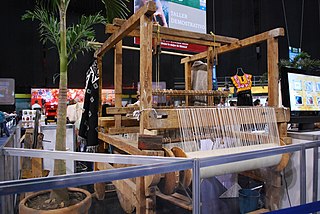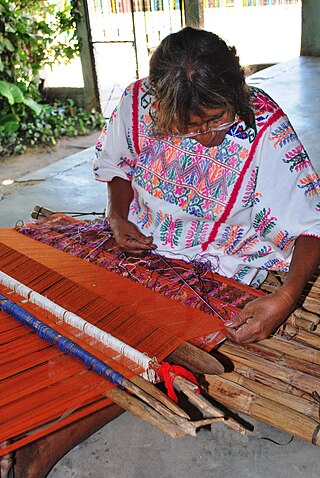
Guerrero, officially the Free and Sovereign State of Guerrero, is one of the 32 states that comprise the 32 Federal Entities of Mexico. It is divided into 81 municipalities. The state has a population of about 3.5 million people. It is located in southwest Mexico and is bordered by the states of Michoacán to the north and west, the State of Mexico and Morelos to the north, Puebla to the northeast and Oaxaca to the east. In addition to the capital city, Chilpancingo and the largest city Acapulco, other cities in Guerrero include Petatlán, Ciudad Altamirano, Taxco, Iguala, Ixtapa, and Zihuatanejo. Today, it is home to a number of indigenous communities, including the Nahuas, Mixtecs, Tlapanecs, Amuzgos, and formerly Cuitlatecs. It is also home to communities of Afro-Mexicans in the Costa Chica region.

Taxco de Alarcón is a small city and administrative center of Taxco de Alarcón Municipality located in the Mexican state of Guerrero. Taxco is located in the north-central part of the state, 36 kilometres from the city of Iguala, 135 kilometres from the state capital of Chilpancingo and 170 kilometres southwest of Mexico City.

William Spratling was an American-born silver designer and artist, best known for his influence on 20th century Mexican silver design.

Ixcateopan de Cuauhtémoc is the head town of the municipality of Ixcateopan de Cuauhtémoc, located in isolated, rugged mountains in the northern part of the Mexican state of Guerrero. According to tradition, it is the final resting place of Aztec Emperor Cuauhtémoc, whose alleged remains were found under the parish church here in the mid-20th century. This church has been converted into a museum with displays a number of pre-Hispanic artifacts, offerings left in honor of the emperor and the alleged remains of Cuauhtémoc himself. This has been refuted by later research and by a Judging Commission of the Mexican government in 1976.
Federal Highway 95 connects Mexico City to Acapulco, Guerrero. The Autopista del Sol is a tolled alternative, which bypasses several towns of the state of Guerrero, including the city Iguala, and thus reduces transit time between Acapulco from Mexico city from 8 hours to almost 3.5 hours.

Pilcaya is a municipality in the Mexican state of Guerrero. The municipal seat lies at Pilcaya. The municipality covers an area of 62.1 km².

Taxco de Alarcón is a municipality in the Mexican state of Guerrero. It covers an area of 650.7 km² and includes 121 communities. The municipal seat lies at Taxco de Alarcón. The population was 105,586 at the time of the 2020 census.
Amador Lugo Guadarrama was a Mexican painter, graphic artist, writer and cultural promoter, best known for his landscape painting and the founding of several cultural institutions. He began painting when still a child, attending the Escuela al Aire Libre de Pintura in Taxco then developing his career in Mexico City. At that time, the Mexican muralism school was still dominant. Lugo related to its aesthetics but not so much to its politics, so he participated in the founding of various institutions such as the Sociedad Mexicana de Grabadores and the Salón de la Plástica Mexicana which provided opportunities for artists outside the dominant movement. He also worked as an educator, writer and cultural promoter, mostly in Mexico City and his home state of Guerrero.

The Grutas de Cacahuamilpa National Park in the Mexican state of Guerrero, Mexico, is best known for the Grutas de Cacahuamilpa Caverns. It is also home to the Grutas of Carlos Pacheco, a smaller system, as well as two subterranean rivers which have carved out tunnels in the rock. The park has outdoor pursuit attractions such as rappelling, and rock climbing in Limontitla Canyon. as well as the two underground rivers to explore. It also has a small botanical garden, a pool and places to camp.

The Fondo Nacional para el Fomento de las Artesanías or National Fund for the Development of Arts and Crafts is a dependence of the Secretariat of Social Development (SEDESOL). It was established in 1974 to promote and protect traditional Mexican handcrafts. The agency has four main programs including artisan training, retail selling and the sponsoring of craft competitions as the local, regional and national level. FONART directly helped 26,600 artisans in 2006, but the agency has been criticized for being inefficient and not meeting the demands of national transparency laws. Currently, it seeks the capacity to authenticate crafts on a national and international level due to competitions from imitations from Asia.

José de la Borda was a Spaniard who migrated to New Spain in the 18th century, amassing a great fortune in mines in Taxco and Zacatecas in Mexico. At one point, he was the richest man in Mexico. He is best remembered today through several architectural works that he sponsored, the most monumental being the Santa Prisca Church in Taxco.

Xihuacan is a Mesoamerican archeological site located on the Costa Grande of the Mexican state of Guerrero, near the small town of La Soledad de Maciel, and the larger towns of Zihuatanejo and Petatlán. While pieces had been found at the site earlier, including the King of La Chole stele and Mesoamerican ball court rings, formal excavations were only recently begun. The site had been occupied for over 3,000 years and by three cultures, with contact with other Mesoamerican cultures such as the Teotihuacan and Olmec. Explored areas include what may be the largest Mesoamerican ball court, a 1-hectare (2.5-acre) pyramidal base and a hill with petroglyphs and a probable sacrifice stone.

Amuzgo textiles are those created by the Amuzgo indigenous people who live in the Mexican states of Guerrero and Oaxaca. The history of this craft extends to the pre-Columbian period, which much preserved, as many Amuzgos, especially in Xochistlahuaca, still wear traditional clothing. However, the introduction of cheap commercial cloth has put the craft in danger as hand woven cloth with elaborate designs cannot compete as material for regular clothing. Since the 20th century, the Amuzgo weavers have mostly made cloth for family use, but they have also been developing specialty markets, such as to collectors and tourists for their product.

The handcrafts of Guerrero include a number of products which are mostly made by the indigenous communities of the Mexican state of Guerrero. Some, like pottery and basketry, have existed relatively intact since the pre Hispanic period, while others have gone through significant changes in technique and design since the colonial period. Today, much of the production is for sale in the state's major tourism centers, Acapulco, Zihuatanejo and Taxco, which has influence the crafts’ modern evolution. The most important craft traditions include amate bark painting, the lacquerware of Olinalá and nearby communities and the silverwork of Taxdo.

The Parroquia de Santa Prisca y San Sebastían, commonly known as the Church of Santa Prisca, is a colonial monument located in the city of Taxco de Alarcón, in the southern state of Guerrero, Mexico, built between 1751 and 1759. It is located on the east side of the main plaza of Taxco.

Traditional metal working in Mexico dates from the Mesoamerican period with metals such as gold, silver and copper. Other metals were mined and worked starting in the colonial period. The working of gold and silver, especially for jewelry, initially declined after the Spanish conquest of the Aztec Empire. However, during the colonial period, the working of metals rose again and took on much of the character traditional goods still have. Today, important metal products include those from silver, gold, copper, iron, tin and more made into jewelry, household objects, furniture, pots, decorative objects, toys and more. Important metal working centers include Taxco for silver, Santa Clara del Cobre for copper, Celaya for tin and Zacatecas for wrought iron.

The Triangle of the Sun is a tourist area in the state of Guerrero that runs through the Sierra Madre del Sur of that state. This tourist area is formed by the cities of Acapulco in the south, the pair of Ixtapa-Zihuatanejo in the north, and Taxco in the center of the state. These cities are those that receive more tourists in Guerrero.
Taxco el Viejo is a town in the Mexican state of Guerrero. In 2010, it had a population of 3,172. It is located approximately ten kilometers south of the city of Taxco.
The Ex Hacienda del Chorrillo is a major colonial period silver hacienda located on the north side of Taxco, Guerrero, Mexico. The hacienda was constructed by warriors of Hernán Cortés and is one of the oldest in the region. It was built to take advantage of the area’s abundant water supply to extract silver from ore. The aqueduct built-in 1534 is ruined but still preserved.
















